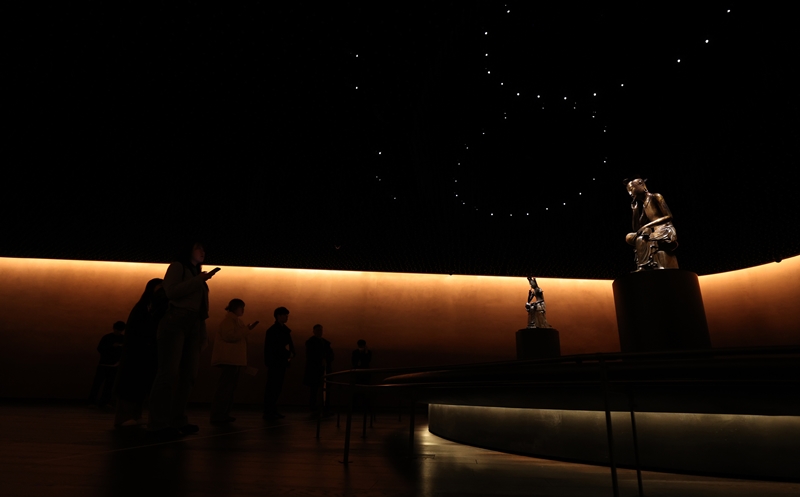
The Room of Quiet Contemplation is exclusively for the two statues of Pensive Bodhisattva. Its ceiling symbolizes the stars and universe and the red clay wall gently exudes a soft scent of cinnamon and cypress in a room of around 440 square m. The floor gets higher the deeper one goes into the room, and the walls are slanted.
Photos = Lee Jun young
The written phrase "Time to ponder extensively and deeply contemplate" precedes going into a dark entrance. A black and white video shows the expansion of the universe and circulation of substances accompanied by peculiar background music. The eyes soon adjust to the dark while slowly walking in. In a flash, the end of the serene passage appears and a slight turn leads to the two statues of Pensive Bodhisattva.
This second-floor room at the museum is the Room of Quiet Contemplation, which houses both relics designated National Treasures.
The statues lightly perch their right feet on their left knees and gently place their right hands on their cheeks. Their eyes seem neither closed nor opened and have mysterious smiles while looking as if in deep contemplation, providing comfort to viewers.
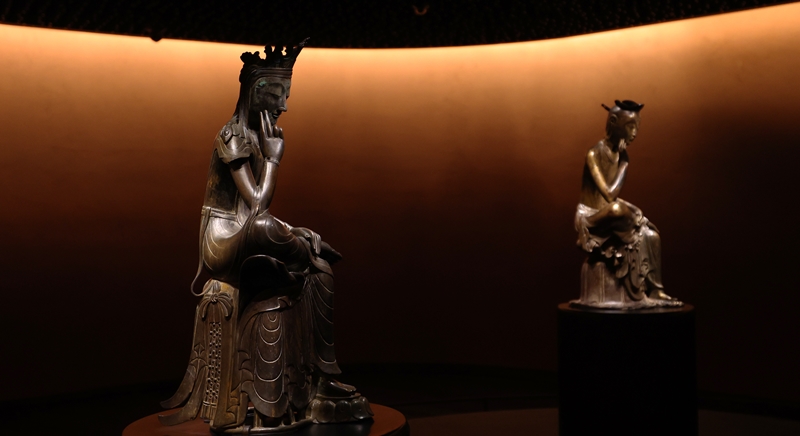
Made in the late sixth century, the Pensive Bodhisattva statue on the left side of the Room of Quiet Contemplation features a sharp nose bridge, clear eyes, fancy ornaments and wrinkles on its clothes and its thinness of 2-4 mm reflects outstanding casting techniques. The statue on the right was made in the first half of the seventh century and shows a simple and restrained style.
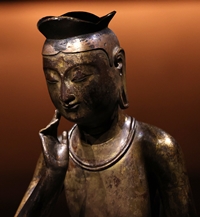
Pensive Bodhisattva statue on the right side of the Room of Quiet Contemplation
The hall has no written signs to allow visitors to focus solely on the statues and interpret them in their own ways. A QR code at the entrance and the exit, however, provides detailed explanations.
No display case means a 360-degree view of the statues from the front, side and rear without restriction for a deeper experience.
"We hope that you have time to focus and think for yourself while looking at the Pensive Bodhisattva statues at this surreal place."
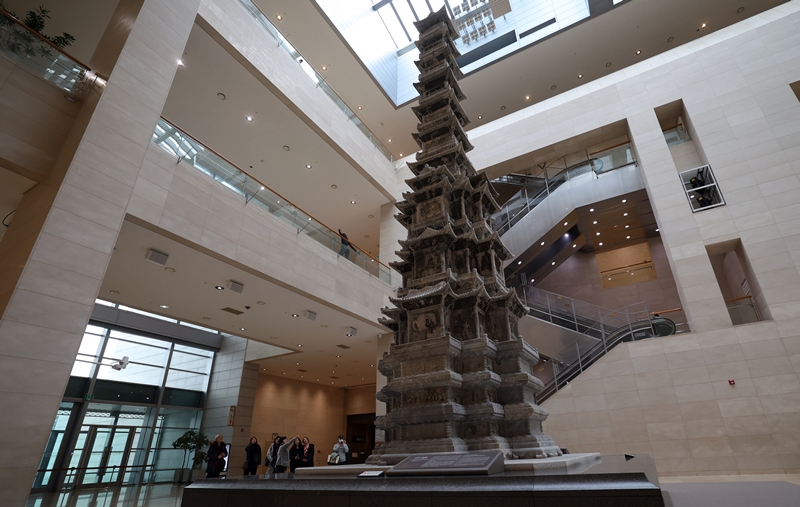
The Ten-story Stone Pagoda from Gyeongcheonsa Temple Site is 13.5 m tall, or the height of a five-story apartment building. Designated a National Treasure in 1962, the relic has a foundation layer and its first to third layers showing influences from Mongolian and Tibetan Buddhism, while the fourth to 10th layers show traditional Korean styles.
The innermost side of the museum's permanent exhibition hall on the first floor sits a towering pagoda. Looking at it from close distances provokes awe and looking up above at its stretched-out appearance does the same. The Ten-story Stone Pagoda from Gyeongcheonsa Temple Site was made during the late Goryeo Dynasty (918-1392).
Most stone structures in the country are made of granite, which is the main rock type in the country, but this pagoda is made of marble and thus has high value. Unlike a traditional pagoda with a simple facade, this model depicts on each side anecdotes related to Buddhism and carved images of Buddha, so both the pagoda's material and style bear special meaning.
A closer look at the pagoda shows at the lowest stylobate (foundation) images of lions, dragons, lotus flowers and nahan (arhats), referring to Buddhist disciples who have reached nirvana, as well as scenes from the 16th-century Buddhist novel "Journey to the West."
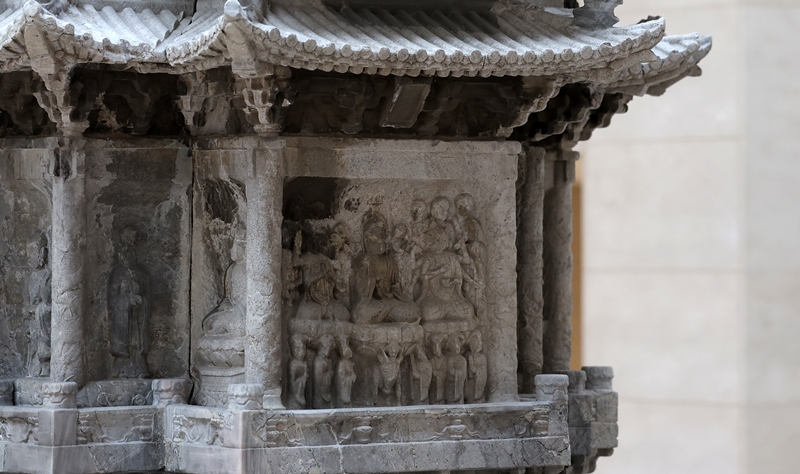
The Ten-story Stone Pagoda from Gyeongcheonsa Temple Site was built in 1348, the fourth year of Goryeo Dynasty King Chungmok's reign, at the temple on the edge of Busosan Mountain in Gwangdeok-myeon Township of Gaepung-gun County, Gyeonggi-do Province. The third floor shows an image of Buddha giving a dharma talk.
The first to fourth layers above the foundation depict scenes of Buddha giving a dharma talk, an image of Buddha and bodhisattvas, guardians of Buddhist teachings and texts on the background behind the pagoda's establishment. From the fifth to 10th floors are engravings showing Buddha making seonjeongin, a hand gesture that signifies his attainment of a certain state and meditating undisturbed, as well as images of him seated with his hands together. The higher the layer, the higher the status of the figures depicted under Buddhist hierarchy.
The pagoda might look fancy on the outside with an imposing majesty, but it has a painful history of being looted. It was smuggled into Japan in 1907 but returned in 1918 through the efforts of many people and was erected in front of Gyeongbokgung Palace in 1960. Because this marble relic is vulnerable to environmental pollution like acid rain, it underwent meticulous preservation and was placed in 2005 inside the museum, where it remains today.
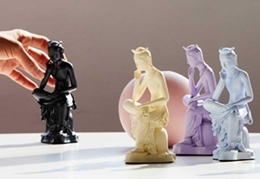
The National Museum Foundation of Korea says Pensive Bodhisattva miniatures were the bestselling item last year at the National Folk Museum of Korea. (National Museum Foundation of Korea)
# Enjoying National Museum of Korea (I)
- To remember the awe felt when seeing the Pensive Bodhisattva statues in the Room of Quiet Contemplation, consider buying miniatures of the statues at the museum. RM, a member of the K-pop group BTS, posted a photo such a miniature at his studio on social media that went viral. The figurines can easily be found at souvenir stores throughout the museum and comes in a range of colors and sizes. Other items based on museum displays are also available.
Regular tours for foreign visitors are available daily. Professional guides and volunteers at the museum explain in an hour the museum's leading collections in English, Japanese and Chinese on free tours offered at select times. The times vary by month or language, so please check the schedule on the museum's website (www.museum.go.kr/site/eng/content/tours_and_services).
km137426@korea.kr
![[Must-sees at Korean museums] ④ Buyeo Nat'l Museum](/upload/content/image/49249826d45a4c1e9e5f2dbd370962cb_20240418151235.png)
![[Must-sees at Korean museums] ③ Gwangju Nat'l Museum](/upload/content/image/a930dfb35b144d6abdfb4483adcc7bf4_20240314090859.jpg)
![[Must-sees at Korean museums] ② Gyeongju Nat'l Museum](/upload/content/image/9a4d39e2842348aca36c10d73fb90f0a_20240216114311.jpg)
![[Must-sees at Korean museums] ① National Museum of Korea (II)](/upload/content/image/1c4dec52513347a98b9c43c9fd62551e_20240118131624.jpg)